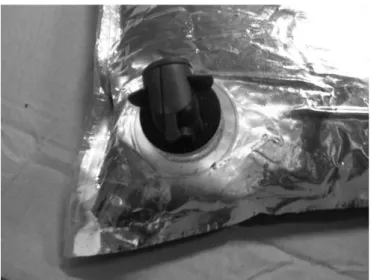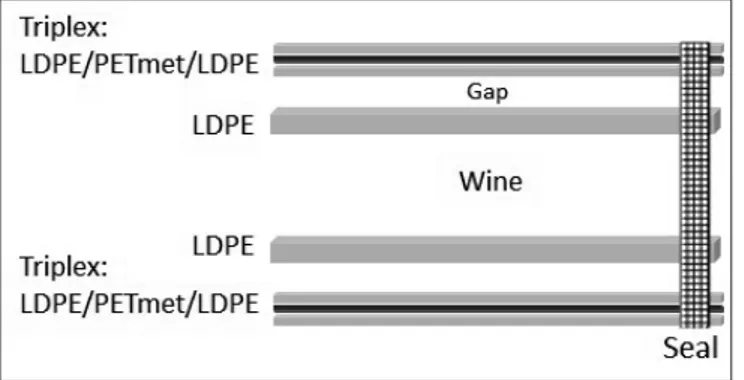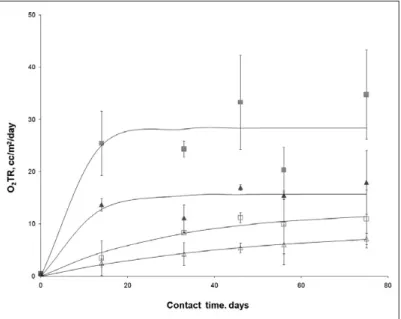PERFORMANCE
OF WINE BAG-IN-BOX DURING STORAGE:
LOSS OF OXYGEN BARRIER
S. FRADIQUE
1, T.
HOGG
2,
J. PEREIRA
2and M.F.F. POÇAS
21
Adega Cooperativa de Murça C.R.L.,
Rua Francisco Barros Carneiro Lopes 4, 5090-134 Murça, Portugal
2
CBQF, Escola Superior de Biotecnologia,
Universidade Católica Portuguesa,
Rua Dr. António Bernardino de Almeida,
4200-072 Porto, Portugal
ABSTRACT
Bag-in-box system is a convenient packaging system for wine. Its barrier to oxygen relies, in many cases, in an aluminium metallized polyester film laminated between two polyethylene (PE) layers as the inner bag. One on the most frequently observed system failures is the ingress of wine into the gap between the layers of the double bag. This study aimed at verifying if that influences the barrier of the system to oxygen. The results showed that the contact of wine with this barrier layer, although through a PE layer, promotes the demetallization and consequent loss of barrier properties. The type of wine, in particular its volatile acidity, and the temperatures were two variables assessed. Results showed that wine with higher acidity and stored at higher temperatures tend to yield a higher increase in oxygen transmission rate of the film.
Key words: wine packaging, bag-in-box, oxygen barrier.
INTRODUCTION
Bag-in-Box (BIB) is a convenient means of wine transportation, also referred to as “cask wines” or “box wines”. It is also well adapted to a number of other liquid or semi-liquid food applications, including milk, sauces, liquid eggs, sauces and
fruit concentrates. This system is available for wine in package volumes from 2 to 20 litres (Dufrêne et al., 2007). The BIB comprises a flexible double bag, a gland (also called “spout” or “flange”) welded to the film, a tap (through which the wine is poured) inserted in the gland and a box providing both mechanical protection and support for visual communication aimed at the end consumer (Dufrêne et
al., 2007).
The flexible bag is typically made of multilayer films with 3 or 4 layers one of which consists of an oxygen barrier material, such as ethylene-vinyl alcohol copolymer (EVOH) or metallized polyester (MET PET). The films of EVOH and MET PET are sandwiched within protective films, generally based on low density polyethylene (LDPE), that also provide good heat sealing properties (Robertson, 2006). The bag includes additionally an internal film usually also made of LDPE, which is not laminated to the external film. The structure is set together only by the seals. A typical structure of MET PET BIB used for wine is shown in fig. 1.
Oxygen is often the major issue in shelf life problems of wines in BIB. Therefore, it is important to known how oxygen actually gets inside the bag when the film is in the presence of wine on one side and air on the other (Dufrêne et al., 2007). The barrier to oxygen of the system can be affected by the intrinsic permeability of the materials and by the tightness of the system, namely joins and seals. The MET PET film has a low permeability to oxygen provided by the vaporized layer of aluminium. This layer is laminated to LDPE layers that protect its integrity. However, the material is submitted to different mechanical stresses during the operations of bag manufacture, wine filling, packaging and transportation, par-ticularly in the case of poor handling practices. This yields to mechanical damage and fatigue of the metallized layer which loses partially its barrier properties by flex cracking (Nicolini et al., 2006; Doyon et al., 2005; Sundell et al., 1992). The damage is not enough for loss of bag integrity in terms of wine leakage, but there is an increase in the oxygen ingress, a decrease of free SO2 and a consequent pre-mature degradation of the wine (Anon, 2006). The films of EVOH emerged as the option to MET PET. They have a lower barrier to oxygen when compared to undam-aged MET PET (Doyon et al., 2005), they are less prone to flexcracking but their
barrier is influenced by the relative humidity (Nicolini et
al., 2006; Anon, 2006). The effect of handling and transportation in the oxygen barrier of the bag (mate-rial, spout and tap) has been studied and damage of the MET PET layer, with visible demetallization, has been reported as occurring mainly near the edges and around the tap (Doyon et al., 2005). This is in agreement with numerous observations made by the authors of faulty BIBs presenting evident signs of demetallization after some time of storage. Fig. 2 shows
an example of severe demetal-lization around the tap. The inspection of this commonly observed defect in BIB shows that it is usually accompanied by the contact of wine with the MET PET layer when the wine passes through the seals to the gap between films. This situation is often not noticed until advanced stages and leakage occurs. Bad storage practices may also originate this situation by contact of wine in the external face of the MET PET layer if leakage in a BIB stored pilled in a pallet drops over the BIBs pilled under the faulty BIB. This situation is some times detected during storage. The apparent damage of the MET PET layer yields to a certain degree of demetallization of the aluminium layer which may have as consequence a decrease on the oxygen barrier provided. This potential loss of bar-rier may have an impact on the wine shelf-life depending on the extent it occurs and on the BIB surface area affected.
The objective of this work was to study how the oxygen transmission rate (OTR) of the external film of the double bag is influenced by the direct contact with wine. The influence of the parameters: temperature, time of contact and type of wine (volatile acidity) was assessed. Samples of film were immersed in wine simulating solutions and stored at different temperatures (23º and 40ºC) for a period of 75 days. Periodically the samples were collected to be analysed for oxygen transmission rate.
MATERIALS AND METHODS
Films BIB
The external layer of the 10L BIB supplied by Conotainer (Madrid, Spain) was used consisting of MET PET laminated with LDPE (45 µm LDPE/12 µm MET PET/45 µm PE).
Wine simulation solutions
The solutions were prepared in order to represent average white (W solution) and red (R solution) wines in terms of the following chemical characteristics: alcohol degree (%), volatile acidity (g acetic acid/L), total acidity (g tartaric acid/L) and reducing sugars (g/L). Tab. 1 presents the characteristics of the solutions used.
Contact between film and solutions
Forty-two pieces of film were randomly cut from a 10L BIB. Ten glass jars with the W solution and ten jars with the R solution were prepared. Two pieces of film were immersed on each jar solution, half of which was stored at 23ºC and the other half was stored at 40ºC. Periodically one jar of each solution and storage temperature was opened, the replicates removed from the solution, dried and prepared for thick-ness and oxygen transmission rate measurements. The pieces edges were removed before measuring to avoid the areas where demetallization have clearly occurred.
Sampling was performed after: 14, 33, 46, 56 and 75 days of contact.
Thickness measurement
Thickness was meas-ured with a micrometer MI20 (Adamel Lhomargy, France).
Oxygen transmission rate determination
The oxygen gas trans-mission rate of the sam-ples was measured using a Coulometric Sensor OXTRAN 2/20 – MH (Mocon, Inc.) with air at 100% gradient of oxygen pressure, at 23ºC and 0% relative humidity (ASTM D 3985 “Standard
test methods for oxygen gas transmission rate through plastic film and sheeting using a coulometric sensor”). The oxygen transmission rate of the film without contacting the wine solutions and of samples after complete demetallization was also measured.
RESULTS
Fig. 3 shows the values of the oxygen transmission rates of MET PET film meas-ured with different times of contact with the solution simulating wine. A trend line described by an exponential model was included to make the analyses more clear. In spite of a considerable variability between replicates, there was a clear increase in the oxygen transmission rate over time as a consequence of the demetallization process. Both the type of wine and temperature had an effect on the barrier’s de-crease: red wine solution presented an increase of 60 times at 40ºC and 20 times at 23ºC, whilst white wine solution presented an increase of 34 times and 12 times, respectively at 40º and 23ºC. The oxygen transmission rate ranged from 0.5 cc/ m2 day (film without contacting the solution) to 103 cc/m2 day (film completely
demetallized). Red wine solution showed a greater impact on the barrier loss prob-ably due to the higher volatile acidity.
The testing conditions followed in this work were more aggressive than the real case because the total edge of the testing pieces were immersed while in the real situation the edge comes into contact with the wine in a few spots where the seal allows for wine transfer. Additionally, in the experiment much more wine was in direct contact with the film as compared to the amount in the real situation be-cause transfer into the gap is limited and slow. Nevertheless, the results found can
Fig. 3 - Oxygen transmission rate of film after contacting solutions simulating: red wine at 40ºC (■), white wine at 40ºC (▲); red wine at 23ºC () and white wine at 23ºC (∆).
be put in perspective considering the real situation of the BIB shown in fig. 2. The total BIB surface area for oxygen transmission (Au) is ca 2,300 cm2 and the OTR
of the unaffected material is (OTR)u 0.5 cc/m2 day. After 30 days there is a surface
area Aa of ca 100 cm2 affected by demetallization that causes an decrease of the
oxygen barrier of ca 10 times. The oxygen transmission rate of that area around the tap (OTR)a becomes equal to ca 5 cc/m2 day. The maximum amount of oxygen
Q (cc) allowed to be absorbed by the wine and still retain acceptable quality can be calculated by equation (1).
(1) Where θu (days) is the shelf-life time when the BIB is unaffected. Once the Aa surface area is demetallized, then the ingress of oxygen occurs in parallel by the two areas with different barriers:
(2) Where θa (days) is the shelf-life time when the BIB is affected. Then,
(3) and
(4) This means that the wine will present a shelf-life time 30% lower than in the case of no loss of BIB barrier.
CONCLUSIONS
Oxygen barrier properties of BIB are greatly affected by poor quality seals, allowing for wine ingress into the gap between the inner and outer film of the bag. Wine with higher volatile acidity tends to yield a higher loss of barrier. In both cases the higher the temperature the fastest and highest the demetalliza-tion. This loss of barrier may have an important impact on wine shelf-life, de-pending on the extent and degree of the demetallization. Therefore, even in the case of global bag integrity and absence of external leakage, the seals should avoid the contact of wine with the external film as this will cause a premature loss of wine quality.
Table 1 - Characteristics of the aqueous solutions for wine simulation.
White wine solution (W) Red wine solution (R)
Alcohol degree (% vol) 12.2 13.0
Volatile acidity (g acetic acid/L) 0.32 0.59 Total acidity (g tartaric acid/L) 5.51 5.72
REFERENCES
Anonymous, 2006. Boxed wine trends drive BIB technology advances. Internet Journal of Viticulture and Enology ISSN 1826-1590; n. 12 (www.inforwine.com).
Doyon G., Clément A., Ribéreau S., Morin G., 2005. Canadian Bag-in-box Wine under Distribution Channel Abuse: Material Fatigue, Flexing Simulation and Total Closure/Spout Leakage Investiga-tion. Packaging Technology and Science, 18, 97-106.
Dufrêne A., Shea P., Boulet J.C., 2007. Guide of Good Practices for the filling of wine in BIB. Perform-ance BIB, França, 24 pp.
Nicolini B., 2006. Bag-in-box, Especificidades Técnicas dos Sacos. InfoWine, 1:4.
Robertson G.L., 2006. Aseptic Packaging. Chapter in Food Packaging Principles and Practice (2nd edn.).
Robertson, G.L. (Ed.), Boca Raton: CRC Press, 381-408.
Sundell H.A., Holen B., Nicolaysen F., Hilton C., Lokkeberg O., 1992. Bag-in-box packaging for wine: Analysis of transport stress in barrier films. Packaging Technology and Science, 5, 321-329.



